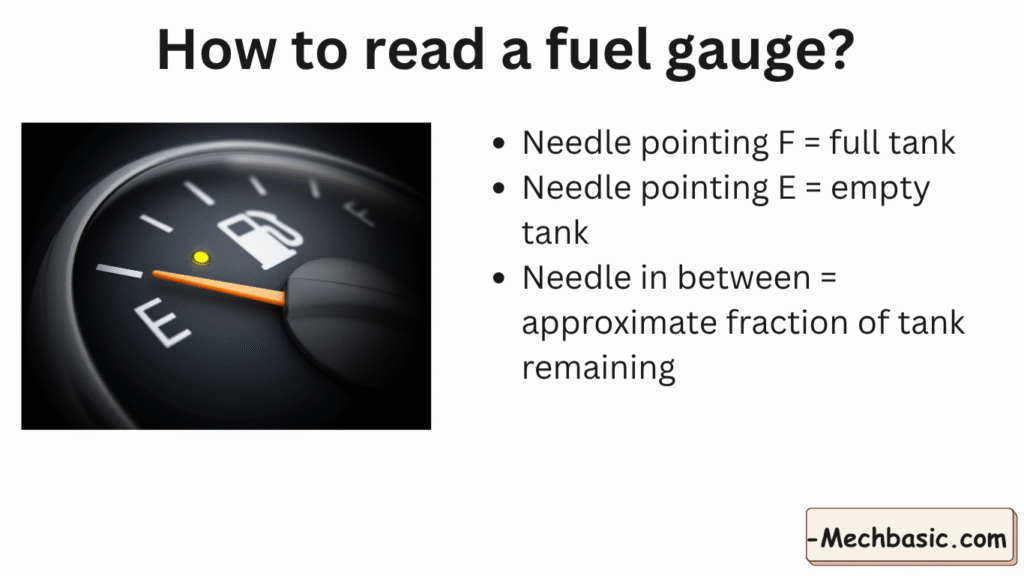Here’s a detailed guide on how to read a fuel gauge in an automobile:

1. Understanding the Fuel Gauge Display
Most fuel gauges display the fuel level using letters, symbols, or digital bars/numbers:
| Symbol / Mark | Meaning |
|---|---|
| F / Full | Fuel tank is full or near full |
| E / Empty | Fuel tank is nearly empty; refuel soon |
| 1/2 mark | Tank is half full |
| Low fuel warning light | Usually yellow/orange; indicates fuel is critically low (often ~10–15% remaining) |
Some digital fuel gauges display the exact percentage or remaining distance (km/miles) the car can travel.
2. Steps to Read a Fuel Gauge
- Locate the fuel gauge on your dashboard, usually near the speedometer.
- Check the needle or digital display:
- Needle pointing F = full tank
- Needle pointing E = empty tank
- Needle in between = approximate fraction of tank remaining
- Observe warning lights: If the low fuel light is on, refuel immediately.
- For digital gauges: Note the fuel percentage or estimated range to plan your next refueling.
3. Tips for Accurate Reading
- Read the gauge when the car is on level ground, as inclines can cause fuel to shift and give inaccurate readings.
- Wait a few seconds after filling the tank; mechanical floats take time to settle.
- Regularly check the fuel gauge instead of relying solely on distance traveled.
- For older or mechanical gauges, understand that the needle may jump slightly while driving; this is normal.
4. Interpreting Fuel Levels
| Fuel Level | Typical Action |
|---|---|
| Full (F) | No action needed; ready for long trips |
| 3/4 to 1/2 | Enough fuel for routine driving; plan next refill |
| 1/4 or below | Consider refueling soon; avoid running near empty |
| Low fuel warning | Refuel immediately; running out can damage fuel pump |
5. Common Misconceptions
- “Empty” doesn’t mean completely empty: Most cars reserve a few liters for safety.
- Gauge jumps while driving: Fuel sloshing in the tank can move the float; this is normal.
- Digital range estimates are approximate: They rely on recent fuel consumption and may vary.
✅ Summary
- Fuel gauge shows how much fuel remains in the tank.
- Read the needle or digital display to estimate fuel level.
- Observe low fuel warning lights and refuel timely.
- For best accuracy, check on level ground and understand that the gauge may fluctuate slightly.
💡 Tip:
To avoid running out of fuel, try not to let the tank drop below 1/4. This also helps protect your fuel pump.
What is between 1/2 and 3/4 on a fuel gauge?
Between 1/2 and 3/4 on a fuel gauge is 5/8 (five-eighths) full.
What is bigger, 3/4 or 1/2?
3/4 is bigger than 1/2.
What does 1 and r mean on a fuel gauge?
On a fuel gauge:
- 1 (or F) means the tank is full.
- R (or E) means empty or reserve — very little fuel left.
Other courses:



